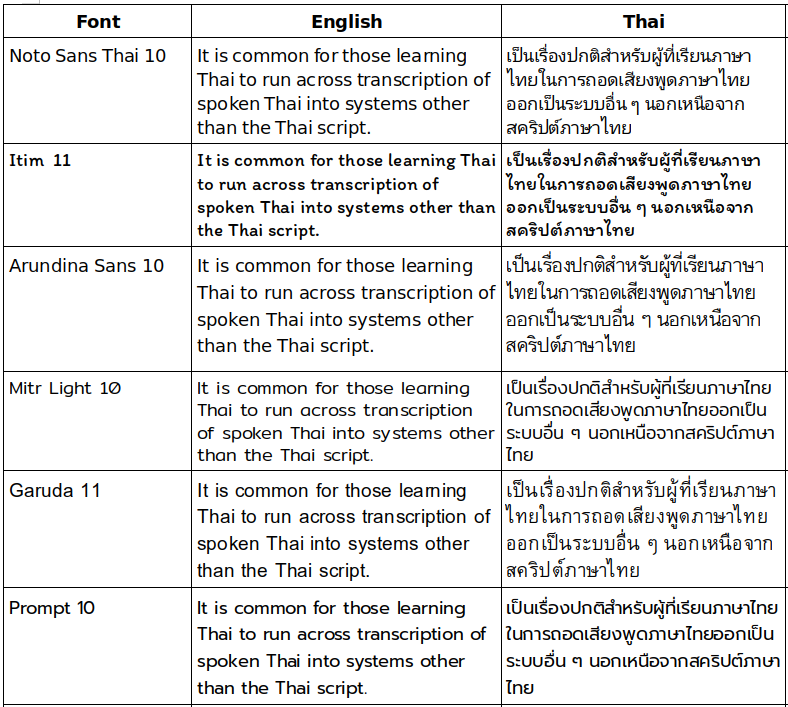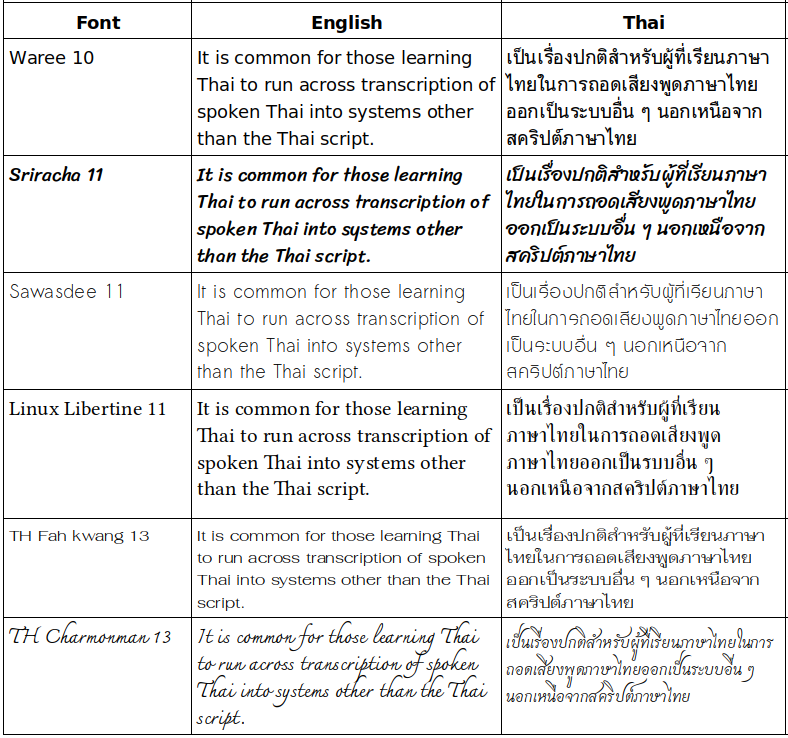Typing in Thai 26 Aug 9:30 PM (last month)
Updated 30-Aug-2025
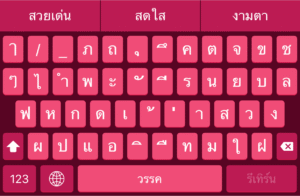
- See also Thai Keyboad Layouts
- See also Tswipe-Pro Android keyboard
- See also Free Thai Font Collection
There are at least two parts to typing in Thai:
- Software for the device (computer, mobile) to enable a Thai keyboard
- This is generally dealt with by the operating system (Windows, Linux, MacOS), or in the case of Android it is a choice of keyboards which are installed from the Play Store as applications.
- Learning to touch-type in Thai, using a training tool (software), or simply the old-school way of having a Thai-enabled device and a set of training pages to work through.
Many previously enjoyed Thai typing websites and apps are no longer available (standard Internet link-rot). As of August 2025, these are the Thai typing tutors, games, and tests still available.
There are a variety of Thai language touch typing programs, as well as virtual keyboards to support Thai. Discussed below are programs in learning to touch type the Thai keyboard. This will always be different than typing or swiping letters/words on a mobile device, as the latter requires eyesight (is not actually touch-typing).
For Android, see Gboard (find at Google Play store) which is the successor to Tswipe-Pro or Microsoft Swiftkey. Unfortunately Heliboard doesn't have any kind of swiping (and no Thai dictionary), and AnySoftKey does not have swiping in Thai (though it does have it in English, and it does have a Thai dictionary).
Thai Language Touch Typing desktop applications
For Thai Language touch typing practice, there are different programs for Mac OSX and for Microsoft Windows.
Fonts Needed for Thai Typing Tutor
You will need the DBTT font for this to work. Install as per your operating system (for Windows, simply drag and drop the dbtt.ttf file into the c:/windows/fonts directory). However, there are lots of fonts out there, especially this Free Thai Font collection.
Browser-based Thai typing instruction, practice, and tests
Thai typing trainers
These generally go step-by-step for learning each key:
Thai typing games and tests
These already presuppose having learned the rudiments of Thai typing:
- Type-thai (game)
- Thai-language (game)
- 10 fast fingers (multi-language / keyboard layout tests)
Thai virtual keyboard
- Lexilogos has some tools (including an IPA keyboard)
Several websites with same content
These sites have seemingly copied Javascript, which is found on multiple sites (same script / functionality). These may be useful but clearly folks are copying each other, likely without permission. These are all more-or-less typing tests rather than typing instruction.
Gau Gai กอ ไก่ – Second Edition 6 Aug 2024 9:33 PM (last year)
Updated 04-Aug-2025
Changes to 2nd edition of the Consonant Cards
NOTE: These will be available for sale in 2026
There are both substantive and subtle changes to the Thai Alphabet Cards. For the Thai Consonants, we add the ten numbers (0-9) as ten additional cards, and then on the consonant cards themselves, the significant changes are:
- Multiple English Transliteration / Transcription (Haas/AUA, IPA, Paiboon)
- Multiple font (typeface) variations (JS Thanaporn, JS Sirium, Purisa, JS Chanok, JS Chawlewhieng)
- Improvements to the tone graph, and
- Indicating the tone rule for the class inside the image for the consonant (an attempt at a visual mnemonic for tone class rules/tone class membership)
What has not changed (and remain from the original edition) includes:
- The Sammy Diagram for the manner and place of articulation of the consonant sound;
- The Thai consonant name;
- The writing order and direction;
- An indicator of a dead or live consonant (triangle or circle);
- Inside the dead/live indicator, the sound for the consonant when it is in final consonant position;
- An indicator of the tone rules for the class (mid-tone for long vowels, low-tone for short vowels);
- The name of the class to which it belongs; and
- The number of the card (in the deck order)
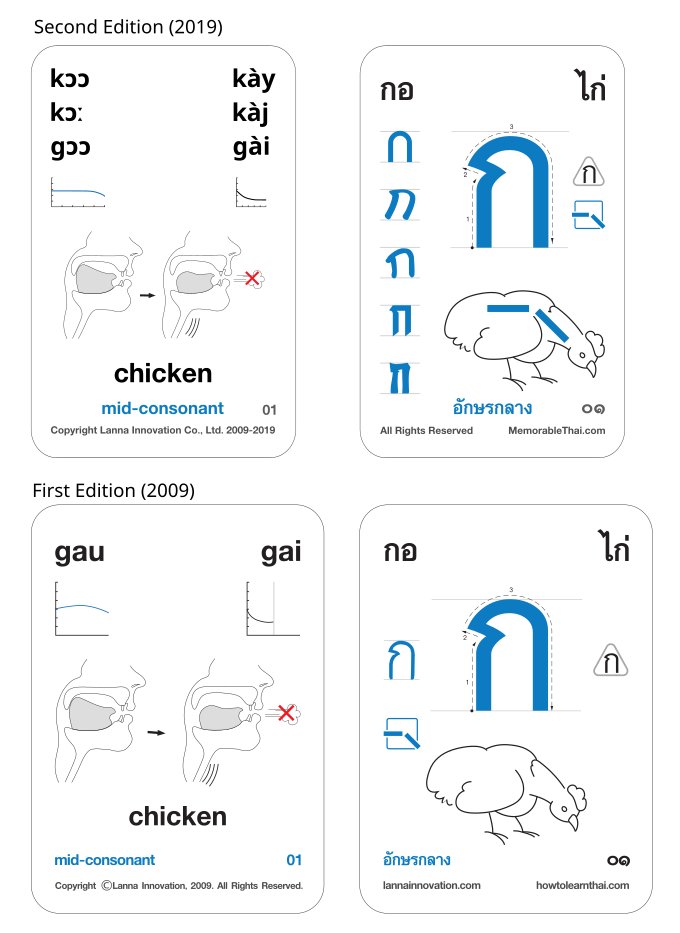
Thai Tones – Background Notes 6 Jun 2024 11:21 PM (last year)
Updated 03-Aug-2025
The five tones of Central Thai (Siamese) have idealized forms that are produced and have been tested synthetically to determine recongition boundaries. However, in running speech there is considerable variation that can be Intraspeaker differences (different tone articulations at different points in time) Interspeaker differences (differences between individuals and between groups) Stressed syllables High and low tones neutralized to mid tone on short checked syllables (unstressed). See: Gandour 1975. Laryngeal coarticulation (which sometimes happens, not always and not with all speakers) Tone has also been proposed as being segmental, namely assigned to > Thai is a mora-timed language, which has a bimoraic requirement on stressed syllables. This is evidenced by segment dis- tributional requirements, including the epenthesis of a glottal stop to augment underlyingly open syllables containing short vowels. -- Moren & Zsiga
How to Learn Thai 6 Jun 2024 11:21 PM (last year)
Updated 03-Aug-2025
Thai language learning happens, regardless of teaching and learning methods are used. The question is which methods are more efficient and more enjoyable. As the educator Shanahan once compared teaching methods to medicine: "The iron lung is a good intervention, the polio vaccine is better".
Theories and Methods
There is nothing so useful as a good theory. They inform our research, and research-based or evidence-based teaching methods. It is they that are discounted when there is no significance or effect size in favor of the theory. There are research areas that may impact Thai language learning effectiveness, including:
- Developmental psychology
- Second language acquisition
- Educational psychology
- Linguistics (phonetics)
- Learning to read
- Learning to write
- Mnemonics and memory
Learning Thai Tone Rules 6 Jun 2024 11:21 PM (last year)
Updated 03-Aug-2025
Thai people do not learn tone rules per se, at least not until around the 3rd or 4th grade (age 10 or so). Even then, few get a firm understanding of the various rules for tones that adult foreigners are taught. Rather they know how to speak Thai correctly because they have learned the skill of speaking and listening, and then reading and writing in Thai.
That is, they learn tones by simply learning tones as they are spoken in the context of utterances, and later in terms of deciphering letters and words in reading and writing Thai. My eldest son didn't really get the hang of tones until around age 4. At age 5 (kindergarten year 2), he was taught to read Thai by the basic phonics sounds and sound blending. This is akin to Native English speakers learning English.
Childhood Language Learning Approximate Order
There is much overlap with these so it is not a discrete, step-wise linear process, but more or less, the order of language learning is as follows, and increases in the complexity of phonemic awareness:
- Learn to recognize sounds (utterances)
- Learn to speak (reproduce utterances)
- Learn the alphabet song (Thai has one, though it is only for consonants)
- Recognize alphabet letters (be able to recall their names out-of-order
- Produce the sounds of letters (distinct from their names)
- Sound blending to produce syllables, words, and phrases
- Reading syllables
- Reading for meaning
- Learning new words, phrases through reading
We think of words, but there is much more than words at work in language. Sound patterns, word patterns, grammar patterns, and even punctuation. Any study of rhetoric produces a panoply of figures of speech.
Where in here are tones learned? For native language learners (children), tones are recognized as distinct along with sounds, and are learned as aspects of speech utterances. To be sure, tones have different qualities in terms of vowel length (discussed more below), and are a characteristic of consonants (and tone marks) in written Thai.
While utterances can be discussed in terms of sounds and syllables, it really is the utterance that is produced and decoded, and not individual letters, syllables, words, or phrases. Utterances have tone, and tone should be learned as an aspect of an utterance, at least initially. Why? Because that is how native speakers do.
Tones as difference
Tones in Thai are distinct from each other in at least two ways:
- Contour (shape)
- Length (duration)
While it is obvious to any Thai language learner that there are five tones, that is not quite accurate. Vowel duration is a meaningful distinction in Thai. As well, the tone contour of a short vowel and a long vowel are not identical. In addition, there are some intermediate length vowels, not quite short and not quite long.
Thai vs English Language 19 Jun 2022 1:18 AM (3 years ago)
Updated 03-Aug-2025
For someone who is learning Thai as a second language (and knows English), it is useful to get an overview of the differences between the languages so that certain assumptions don't impede language acquisition.
Differences in Written Thai from Written English
- The Thai script is used, and may include use of Thai numerals (Thais also use standard Arabic numerals).
- The Thai script has a single case, there is not upper-case / lower-case distinction.
- The Thai script is largely written without spaces between words. Some spacing can be used between clauses, but complete sentences can be without any spaces between all the words in the sentence.
- There is much less punctuation in Thai, though modern Thai can borrow from English (commas, periods, question marks), they are not in the Thai language.
- There is a huge variety of Thai typefaces / fonts, and at least two major styles (looped and loopless) which makes recognizing Thai letters difficult for a beginner.
- The Thai script has close to 100 different characters (vowels, consonants, tone marks, punctuation, numbers, etc.). Some characters are obsolete, but are still used for government records, such as on license plates.
- Thais typically use both the Thai and the English keyboard layouts, switching to English for Arabic numerals, brackets, quotation marks, commas, periods, the equal sign, etc.
Difference in Thai from English Sounds
- There are several sounds in Thai not found in English.
- There are several sounds in English not found in Thai.
- Thai consonants can have different sounds depending upon whether the consonant begins or ends a syllable.
- There are consonant clusters in English not found in Thai.
- Thai has a trilled R but it is generally pronounced as an L.
Difference in Thai from English Tones
- Thai is a tonal language and English is not. English uses tone for meaning, whereas Thai uses tone as a sound distinction (as well as meaning).
- The tone of the utterance is generally in the written form (with a few exceptions).
- There are five tones (high, falling, mid, low, rising), though also the tones are different for short and long vowels (one can say there are 10 tones).
Differences in Thai Grammar from English Grammar
- Adjectives follow nouns in Thai and do not precede them as in English (the cat black vs. the black cat).
- There are no verb tenses in Thai, but rather they use auxiliary verbs and prepositions to indicate time.
- Thai has a heavily used politeness particle, spoken differently by males and females (krap/ka).
- Thai has S-V-O just like English.
- There are no plural forms of nouns in Thai, but Thai uses a range of classifiers (and/or numbers) to indicate quantity
- Thai has question words (rather than change of sentence order and a question mark).
- There is no equivalent to yes and no in Thai, but there are other ways of expressing affirmation and negation.
- There are male and female first person pronouns in Thai.
Story Learning Foreign Languages 16 Jun 2022 6:18 PM (3 years ago)
Updated 03-Aug-2025
Olly Richards' Story Learning
Olly Richards' a polyglot, has a method for language learning he calls story learning. He has actually taken out a trademark on this term, and claims that it protects "the invention of a powerful new method." But in fact patent protects inventions, trademarks only protect trade marks. That said, there is no real invention here, as all the techniques have been well-researched, most notably by Stephen Krashen and his collaborators.
> You won’t find this anywhere else. That’s because Olly actually invented this brand-new language learning method.
Nonsense. Of course Olly Richards knows about Stephen Krashen.
> I spent a lot of time studying Stephen's work while completing my masters in linguistics.
Language Acquisition and Comprehensible Input
Krashen makes a distinction between language learning and language acquisition. The former is more or less the activities of learning, whereas the latter is the actual acquisition of language (which is not altogether a conscious learning). Krashen has several theories with research that provides good evidence for them. The main point is to focus on comprehensible input, and Krashen says that reading self-selected books for pleasure is one of the most effective approaches to learning acquisition. This of course is Olly's point as well.
Olly Richard's Masterclass
The Story Learning Method
Olly Richard's has a step-by-step approach to reading, and has authored numerous books in several languages that provide the sort of graded reader useful in language acquisition.
- Choose reading material at your level
- Read for completion (complete each chapter)
- Read for gist
- Go back to the start, read again
- Check for unknown words, but only those repeated
- Repeat
Context and Value of Story Learning
Story Learning, aka reading self-selected comprehensible input, is a good approach, as it is completely derivative of the already-understood natural method as documented by Krashen.
The parts of this method that are more dubious is the actual learning material (written by a non-native speaker) which is a not very good attempt to create a graded reader.
> I use this book with my students. It's not perfect, but there's not a lot to choose from. A few observations: > 1) It uses European Spanish. This means some things sound odd, or even confusing, to Latin Americans like me. > 2) It has errors. I purchased the Kindle version of the new edition that will be released in paper in November 2018. This edition eliminated the dragon story and added a space story about a capsule. This story seems rushed, and it not only has errors in the Spanish, but also one in the story itself. Hiring a proofreader won't hurt. > 3) It contains too many low frequency words. This is most definitely not for beginners. Some words are unknown even to natives, such as pergamino in the Knight story. I re-typed part of a story into a text editor where I use a user dictionary containing the top 20K Spanish word forms. There's about 6-10% of word forms OUTSIDE THE TOP 20K! Something written for "beginners" should focus on high-frequency words instead. Anything beyond 2% unknown words becomes a chore. > 4) Reading is made difficult by the names. Some stories use really odd names instead of native Spanish names. This makes reading more difficult even for natives. > 5) As for the stories themselves, the first one is boring. The second one is mildly interesting. The remaining ones are more interesting and I kept reading them like I would with native materials. But sometimes you wonder if something was lost in the translation (Remember Olly's native language is English), because it can be difficult to follow what's going on.
That said, there are several other elements needed for foreign language learning:
- Learning to hear the unique sounds of a language
- Learning to read / speak / pronounce written words
- Learning to write
- Learning to read fluently (out loud) to capture the meter and tones of the language
- Access to comprehensible material (audio and books)
- Access to tutors for conversation, question answering, assessment
- An overall guide to the language for orientation
- A spaced repetition system for vocabulary retention
As we can see learning to speak and learning to read are inseparable (as is obvious from a literary approach to second language learning).
We definitely agree with the approach of comprehensible input and self-selected reading. It is how educated people learn literary language and spoken professional languages.
Learning how to listen 10 Dec 2021 5:28 AM (3 years ago)
Updated 03-Aug-2025

This is about learning how to hear a new language. Many so-called experts recommend trying to speak immediately, but one cannot say what one cannot hear. Also, while in some cases sounds are considered the same, there are nonetheless differences. Capturing and recognizing these differences is important.
Pigeon Holes
When there are recognized sounds that are different enough so that the IPA symbol is different, then those sounds need to be recognized as different. There are many examples of this, but conceptually think of the IPA as a set of pigeon holes. Every language has pigeons in some of the holes but not in others. Languages have overlaps in terms of pigeons in holes but also some sounds are in some languages but not in others.
As well, when there is not a nearby hole filled with a pigeon then a pigeon can fill that nearby hole as well, from the perspective of the listener. That is, there is less of a distinction between similar sounds because there is no minimal pair for that sound.
In Thai, there is chau chang (and chau chur) which is usually transliterated as a ch. However, there is no sh sound and so Thai people have a hard time distinguishing between English sh and ch. In fact, listening carefully, one can hear that some Thai people pronounce chau chang like sh and some like ch.
In Thai, there are p, b, and bp (bpau bplaa) sounds. In English there is no bp and so English speakers have a hard time hearing bp and tend only to hear a b sound.
Use of the IPA alphabet in language learning
Using the IPA alphabet is very useful to helping sort out these overlaps and gaps, and help train the ear to hear what it normally does not. It is also helps to have an indicator of what needs to be said differently when learning to speak a new language.
I first thought it was a waste of time to use the IPA alphabet when learning a language. Since I did not desire to become a linguist and only wanted to learn Thai, it felt like an additional burden. However, because of the differences in sound, in both listening and speaking, the use of the IPA is actually very helpful, and is worth the effort in this regard.
- The IPA highlights the need to listen for sounds we do not hear, if they are not in our native language, and indicates the sounds to listen for
- The IPA points out minimal pairs to learn, to distinguish between two (or three) sounds
- The IPA can indicate tones as well, but use of them is not common
- The IPA indicates the place and manner of articulation, which provide clues as to how to create the new sounds
For expansion on place and manner of articulation, sammy diagrams are useful
Sammy diagrams in language learning
Sammy diagrams are static, side-view images of the mouth and its component parts (tongue, lips, and jaw placement). However, many sounds are not static mouth configurations but have movement. Three dimensional MRI video is the highest resolution information, but MRIs are damaging to DNA and it is impractical to use them for feedback on learning to speak a language. However, one or two sammy diagrams can be helpful nonetheless and provide clues toward properly articulating sounds.
Sammy diagrams combined with an IPA vowel table can be very helpful in targeting specific vowel sounds. See this useful video explaining and providing examples for the vowel chart.
Tone graphs in language learning
Tone contour graphs are especially useful in tonal languages, but can be helpful with any language. They provide a visual display of tone frequency over time. With tools such as Praat speech analyzer.
If one has idealized tone contours, then one can visualize tone (pitch) with practice recordings using Praat. This allows for getting feedback on tone via computer. Tone contour includes both the changes in pitch and the time dimension, so that long and short vowels are being produced accurately with regard to relative length.
Vocabulary Lists for Learning English 12 Mar 2021 8:33 AM (4 years ago)
Updated 03-Aug-2025
Language learning progression and vocabulary lists are not the same thing. However, good lists -- those that focus on the more frequently occurring lemmas -- can be enormously helpful in efficient language learning acquisition.
How many words are learned at each CEFR level?
CEFR Levels are meant to show meaningful degrees of foreign language acquisition: A1,A2,B1,B2,C1,C2. Vocabulary comprehension can be tested along with each level, and an average amount of vocabulary learned at each level can help learners focus on word acquisition. CEFR is not based on vocabulary size but on communication skills, hardly the same.
There is some research that provides benchmarks, but the studies are in different contexts and it is difficult to generalize. In addition, there is a distinction of active vs. passive vocabulary that is hard to measure meaningfully.
One research publication did try to map levels to vocabulary and CEFR levels is Milton & Meara (2003) which provided the following table:
A1: 0-2,000
A2: 2,000-2,750
B1: 2,750-3,250
B2: 3,250-3,750
C1: 3,750-4,500
C2: 4,500-5,000
The test uses was the XLEX which can measure up to 5,000 words so C2 should actually be 4,500+ or 4,500-5,000+. This scheme has pedagogical value (namely, justifies learning a number of words at each level) but is altogether too neat and tidy. The question is, how many words are needed for practical ability to continue learning a language?
Minimum number of words to enable self-learning progression
There is a minimum number of words that are needed for anyone to be able to progress on a self-initiated way, specifically via reading, but also other media. In a sense CEFR levels are nice and neat but really address a testing need, rather than learning milestones.
It is also the words in a particular context that are most important. For academic learners, the low frequency technical words are as or more important that the high frequency words not in context. At the very lowest level, a minimum 500 headwords might be needed for A1. The next level that can be better measured is B2 which requires at least passive comprehension of the first 2,000 words in the General Service List. All other things being equal, this means 500 words per level: A1,A2,B1,B2. This would be at a minimum, and more applicable to those focused on academic or technical fields, rather than general fields.
What this is meant to show is that the numbers above are a bit inflated. A1 could simply be 500-1,500 words. B2 could simply be 2,000-3,000 words. C2 could indeed be the 5,000 words as noted above, which would mean adding another 1,000 words at C1. This also shows that the CEFR levels are not all equal nor should they necessarily have such discrete and standardized numbers of words partitioned across them.
Native Speaker Vocabulary Size
20,000 to 30,000 words are considered standard for a native speaker vocabulary. If a CEFR C2 is around 5,000 words, it is quite a long way from 5,000 to 20,000-30,000 words. The average 8-year-old native speaker already knows 10,000 words.
Words are not the most important metric, but rather lemmas. For 75% of daily language, only 800 lemmas are needed. For tv shows, 3,000 lemmas. For novels and quality newspapers, 8,000-9,000 lemmas. It is these lemmas that are the target of the General Service List as well as specialist vocabulary lists.
Generalist and Specialist Vocabulary Lists
Beyond the General Service List, there are three other general vocabularies that are in wide use:
- New General Service List (NGSL) 2,800 core general English words, 700 core spoken English words (NGSL-S)
- New Academic Word List (NAWL) 960 Academic words
- TOEIC Service List (TSL) 1,200 TOEIC words
- Business Service List (BSL) 1,700 Business words
Use of Vocabulary Lists in Teaching and Learning a Foreign Language
Because the lemmas efficiently leverage comprehension, focused vocabulary learning could and should make good use of them. Incidental lessons at the primary and secondary level should also use these.
Power of Words by Charles Browne
Anki for Learning Thai 10 Mar 2021 5:42 AM (4 years ago)
Updated 03-Aug-2025

Anki is one of the most popular flashcard software programs for memorization, and it is one of the first. It includes a spaced repetition algorithm for optimized learning, and a host of configuration options.
Anki is multi-platform (Linux, Mac, Windows, Android, iOS), and free (except for iOS). There is also a web version, and all apps support synchronizing data via the website (again, for free).
Anki Original Use Case
Anki means memorizing in Japanese and was originally created to help with memorizing Kanji characters for learners of Japanese as a second language. It has since been adopted for dozens and perhaps hundreds of other languages, as well as any other subject for which a memorization tool can be used.
However, it can be used for anything requiring remembering, including definitions, formulas, historical facts, etc.
Anki for Learning Thai
Anki remains a great tool for learning languages, and Thai is no exception. Simply, it helps with the memorization process, once one learns something, such as language vocabulary. Anki is composed of decks, notes, and cards. Notes have fields that are basically the columns in a spreadsheet, and rows are each note.
Anki can support different stages of the Thai language learning experience:
- Learning the Thai Alphabet
- Letter names, letter sounds (phonics), consonant class, etc.
- Learning how to pronounce letters, syllables, and words
- Vocabulary building
- Listening comprehension
- Fill-in-the-blank (cloze) for testing recall and comprehension
Anki Decks
Anki decks are decks of notes and cards. One can create many decks, but for a given language it is probably wise to have a single deck unless there are some special features (such as the Thai alphabet with multiple aspects, more on this later).
Anki Notes Fields for Thai - Examples
It is simple to set up fields such as:
- written-thai
- spoken-thai
- written-english
Then for any given word or phrase, one enters the information.
Anki Cards for Thai - Examples
Cards are generated based on templates. For example, for the three note fields above, there can be six actual cards:
- written-thai to spoken-thai: Say the written word in Thai
- written-thai to written-english: Translate Thai into spoken English (note we do not need spoken English for this)
- spoken-thai to written-thai: Write in Thai
- spoken-thai to written-english: Translate Thai into spoken English (note we do not need spoken English for this)
- written-english to written-thai: Translate English into written Thai
- written-english to spoken-thai: Translate English into spoken Thai
Pronunciation and Translation
Of course the number of fields could be reduced or increased to limit the number of cards generated. For example, when first learning vocabulary, pronunciation will be difficult and it would be very helpful to include additional fields. However, as time goes by, the cards generated could be reduced to only written-thai and written-english.
Initially, even more fields could be added, for example to provide phonics for sounding out letters and syllables. Once these phonics rules have been internalized, then this aspect could be removed, not so much by editing the notes but simply removing cards that are generated from those fields.
Audio recordings
For recording audio, it is quite simple: click the microphone button, speak, click save. It does all the work of managing the mp3 file. There is a text-to-speech functionality that can use Google Translate and other online services for recording audio. This means one can access spoken audio for written words on-the-fly without having to pre-record these files oneself.
However, this functionality is not yet in Ankidroid, and is only available on the desktop distributions (Linux, Mac, Windows). Should come soon though (2021).
Spaced Repetition
Anki supports spaced repetition for active recall. That is, questions are provided at optimal intervals which prompt active recall, and when actively recalled, help move the information from short-term to long-term memory. The algorithm used is based on SuperMemo 2 (SM2). This is a scheduling algorithm which reintroduces a flash card at an optimal time (shorter if difficult to recall/cannot recall, longer if can recall). The effect is to move things from short-term into long-term memory. The actual intervals and other aspects of the recall system can be fine-tuned to one's own individual preferences.
Anki and Shared Decks
Anki users can make their decks available to the general public to download from the AnkiWeb site. Shared decks can be searched for and imported into ones' own collection of decks. However, shared decks are not the greatest approach when dealing with learning language. The main reason is that one should learn words and then use Anki to remember them, rather than use Anki to learn words. This means that Anki is a tool for remembering, not learning.
More on Anki Notes and Cards
Anki is highly customizable. It has a concept of notes and cards. Notes are the actual bits of information organized as one or more notes. Each note has a set of fields, that can include information in them (or not). Multiple cards can be generated for a given note simply by creating more cards. Each card has two sides, and cards can generate both ways (that is, displayed front-to-back and back-to-front). The built-in cards are:
- Basic (front-to-back)
- Basic (with reversed)
- Basic (with optional reversed)
- Cloze
Cloze is a special case, where the answer is a fill-in-the-blank. There can be multiple cloze cards generated from a single note. However, using a cloze template there cannot be multiple templates.
Supporting Text-to-speech Voices
Currently desktop Anki supports Text-to-Speech (TTS) with multiple languages and services (Yandex Translate, Google Translate, etc.). This isn't yet (February 2021) available in Ankidroid, but is coming soon. Part of the challenge is getting parts of Ankidroid working with Rust so that the functionality can be shared across all platforms.
There are some paid plugins that have extended support for TTS using cloud providers for translation (Amazon, Google), beyond the basic use of Google Translate and other platforms.
Anki already supports recording and playback of audio files, though these tend to make decks large in filesize, and an on-the-fly translation is much more flexible.
Anki desktop Add-ons
Anki supports Anki desktop add-ons which are created by the community and extend the functionality quite a bit.
Anki Resources
Anki Community, Bug Tracking & Development
- Anki Help Forum and Anki Droid Help Forum
- Anki Bug Tracking and a separate Anki Droid Bug Tracking
- Anki on Github
Interesting Discussions on Anki
Prosody in Thai Language 3 Mar 2021 10:23 PM (4 years ago)
Updated 03-Aug-2025
> In linguistics, prosody is concerned with those elements of speech that are not individual phonetic segments (vowels and consonants) but are properties of syllables and larger units of speech, including linguistic functions such as intonation, tone, stress, and rhythm. Such elements are known as suprasegmentals.
Prosody vs. Discrete Phonology
In learning Thai, or any other language, the point of prosody is that learning to say individual consonants and vowels is incomplete, and that syllables, words, and phrases have additional features of pronunciation which deviate from the simple blending of vowels and consonants.
Pure pronunciation of consonants and vowels as discrete units, even when blended together, cannot reproduce standard speech. After all, standard speech is primary and written speech broken down into discrete consonants and vowels must necessarily be an abstraction (as helpful as it may be).
Singing has a big impact on pronunciation, as words are often sung very differently than spoken, in terms of sound, tone, stress, and rhythm. Therefore a beginning learner would find it more difficult to understand Thai (recognize words) in song. This is not to mention that sung Thai is different from spoken Thai in word choice and composition. For intermediate and advanced Thai language learners, singing and songs can be useful in extending the boundaries of understanding, and producing Thai words and phrases.
ร และ ล - R and L
The most obvious change in pronunciation is the R and L, where in spoken Thai (except in formal settings), the R sound is replaced with the L sound. Of course, in written Thai this is not the case, and one learns from the Thai alphabet that ร เรือ (rau rua) and ล ลิง (lau ling) are different from each other, but in practice ร เรือ is pronounced like ล ลิง. Since they both are low class consonants with the same final consonant sound n, all the tone rules apply the same.
In addition, in consonant clusters with ล ลิง, such as กล้วย (gluay) banana, which is colloquially pronounced กัวย (guay). Consonant clusters are a complex feature of Thai and need to be dealt with comprehensively.
Prosodic-Phonological Boundary
Any deviation from standard phonology can be attributed to prosody. There is of course a fine line between phonology-prosody, and so not all deviations are necessarily prosodic, but could be understood as conventional. Careful linguistic study demarcates these lines. For the Thai language learner, it is enough to be aware that the pronunciation rules of vowels and consonants are not enough, and the complex addition of more and more rules to account for exceptions increases the burden on the learner.
Of course children do not learn their native languages through rules and explanations but by listening, understanding, and practicing authentic speech. Adults would do well to try and embrace this repetition, rather than seeking cognitive explanations which cannot be put into practice with any degree of fluency and in fact impede progress to that goal.
TSwipe-Pro Thai Keyboard for Android 14 Dec 2020 6:57 AM (4 years ago)
Updated 27-Aug-2025
Update 07-10-2024 Sadly this app is no longer available, and therefore there is no longer an elegant solution to the Thai keyboard on Android. Sigh.
The standard Android keyboards such as Android Keyboard (AOSP) and Gboard do not display all the Thai characters. Instead, half the Thai characters are not visible until the shift key is tapped. This is a problem for people who do not have the key positions memorized. Therefore a different keyboard is needed.
That keyboard is was TSwipe-Pro.
TSwipe-Pro first swipable Thai keyboard
TSwipe-Pro has been around since 2010, and was the first keyboard to support swiping in the Thai language. Originally it supported three languages: English, Japanese, and Thai. Currently it supports English, Thai, Japanese, Sanish, Polish, and Chinese. It has over 1m downloads and a rating of 4.2 from 10k reviews. It is highly customizable with themes and also supports voice input.
TSwipe-Pro Settings and Configuration
There are a myraid of settings and configuration options with TSwipe-Pro. The most basic are the Theme and various layout options. It is really highly customizable and a very mature keyboard application. First of course, set TSwipe-Pro as the default keyboard.
Thai Keyboard Layouts 8 Jul 2019 12:54 AM (6 years ago)
Updated 03-Aug-2025
This article is about Thai keyboard layouts for desktop and laptop computers, which have a hardware and software component. This does not deal with virtual or soft keyboards or mobile device layouts.
Thai Keyboard Layouts are generally something Thai speakers and Thai language learners have little problem with because of a de facto standard, although there are three specific standards, in practice (along with ISO and ANSI layouts).

Though simple and straightforward, the English Wikipedia regarding Thai keyboard layouts gets things wrong, as is usually the case. The images are incomplete, or mislabeled, or missing relevant information. Wikipedia has been descending into a pit of ignorance for some time now.
ANSI Kedmanee as Standard and Predominant
When dealing with Thai Keyboard Layouts there are a few considerations. In general, this is mostly a non-issue since there is a predominant layout generally available, including in keyboard sticker format: The Kedmanee which was turned into a Thai Technical Standard (TIS 820-2531). ANSI is also the predominant physical keyboard layout (more on ANSI vs. ISO below).

1995 Update to Thai Keyboard Standard - TIS 820-2538
There is a 1995 update to the Thai standard TIS 820-2538, which adds support for Anghankhu (๚), Fongman (๏), Khomut (๛), and Yamakkan (อ๎), which are otherwise missing. These are Pali and literary characters not well known or in use outside of those niches. Note also that the Baht sign (฿) changes its location in the TIS 820-2538 update, and Anghankhu (๚) requires AltGr to access. As well, the percent (%), underscore (_), and plus (+) signs are removed from the Thai keyboard (though the plus sign is available on the separate number pad on 101/102/104/105 keyboards).
While this may be of interest to those (few) regularly typing Pali and Literary characters, for physical keyboards this layout standard is virtually impossible to find, though the software to support it is available in most operating systems (excluding, currently, ChromeOS).

Apple Keyboards and Missing Thai Characters
The ambiguity of which standard is in use as a keyboard map option was present in Apple keyboards for a number of years, in terms of there being a lack of characters on the keys where there were changes made between the standard versions. That is, instead of printing one or both character that would be represented, Apple decided to leave those keyboard character locations blank.

ISO vs. ANSI Keyboard Layout for Thai
While it is very difficult to find any examples of ISO keyboards with Thai language support, for those used to an ISO keyboard layout, that option should be simple to use/adapt as for Thai the extra ISO key has the extinct ฃ and ฅ keys, and the US English keys are backslash (\) and pipe (|). Unfortunately for programmers, those keys are rather important, and for the average typist, a smaller left shift key, and narrower enter key on the home row does impose some ergonomic penalty.
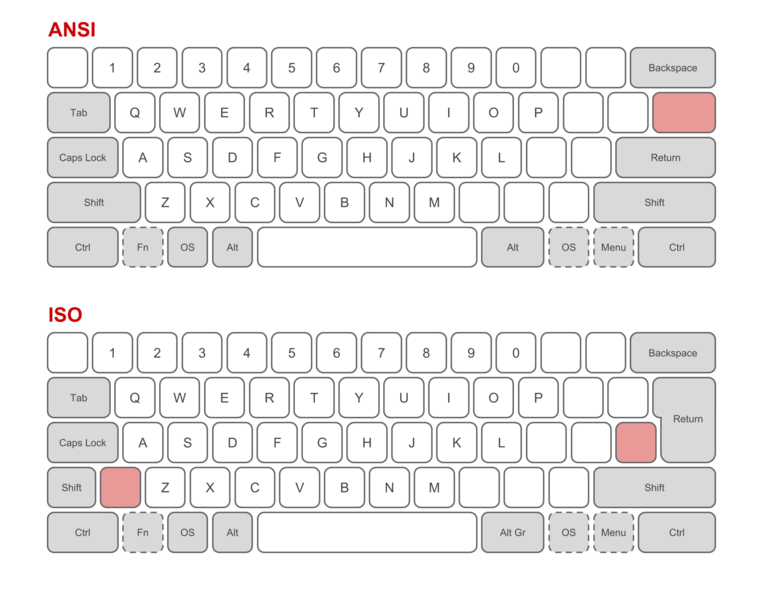
Note that there are a few examples of ISO layout for Thai when looking for laptop keyboard covers. Note the same missing characters as found on earlier Apple keyboards, in terms of support (through lack of contradiction) for both the TIS 820-2531 and TIS 820-2538 standards.

Strange Intermediate Keyboard (Not ISO, Not ANSI)
Special Note: Beware of narrow/tall Enter Key layout
There are several cheap Thai/English keyboards found in various shopping malls that are effectively ANSI in terms of the number of keys and the left side of the keyboard (including left shift width) but have a double-height/narrow enter key, and move the \|ฃฅ key from above the Enter key, to the left of the Enter key. For those used to ANSI keyboards and the more ergonomic (easier-to-reach) Enter key, this keyboard layout results in more errors (both the Enter key which is very frequently used, as well as the pipe and backslash keys). For Thai, the ฃ and ฅare extinct characters and so are only used when discussing the Thai alphabet (which still has them), and not the spelling of any words in use.
Pattachote Thai Keyboard Layout
Pattachote or PattaChote is one option for keyboard layout that is generally discussed but essentially irrelevant. While the keyboard layout is available in most operating systems, it is virtually invisible in terms of actual physical keyboard availability. If one is ever inclined to try out Pattachote, then it would be necessary to design and print one's own keycaps.

Just as with Dvorak vs. QWERTY, it is impossible to find actual empirical studies which show evidence of the superiority of typing speed and error rate improvements when comparing Kedmanee and Pattachote. Theoretically there is more equal use of fingers and less heavy reliance on the right pinky finger than with Kedmanee. Of course those who find Kedmanee tiring or painful might indeed benefit from a change of layout.
Predominance of ANSI and Kedmanee
For simplicity's sake and for maximum compatibility in Thailand (compatible with the vast majority of keyboards available and in use, as well as keyboard sticker sets), the choice should be a 101/104 key ANSI keyboard using the US English and Thai (aka TIS 820-2531) layouts. The 101/104 keyboard has a separate keypad which makes accessing the Roman numbers directly (much easier than switching languages).
Support for European Languages and Thai
If one is designing a dual-keyboard layout, for support of most European languages (using non-ASCII characters), it is possible to use the English (US, international AltGr Unicode combining) keyboard option. This enables the AltGr (right alt key) to act as an option to access more characters. The disadvantage is that it does not map naturally to any european keyboard layout, so for touch-typing it needs to be learned just as any keyboard layout. For those who must regularly type in two or more European languages which a single keyboard layout cannot support, this is a compromise layout option.
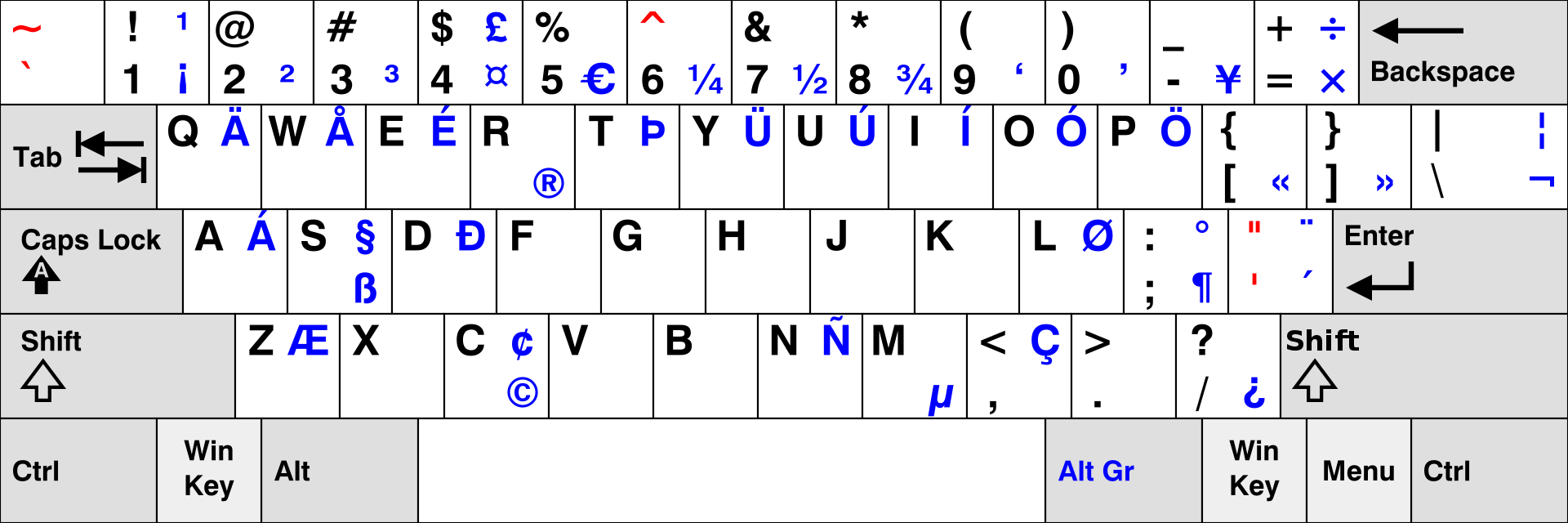
Note: it could be worse:
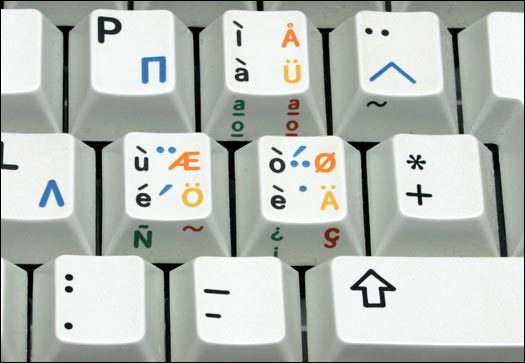
Problem with Dual Language Mechanical Keyboards
There is a significant problem if someone wants Thai + English mechanical keyboards in Thailand (those with Cherry MX keys or similar). These keyboards are either designed with a backlight, and the dual language keycaps are either side printed with Thai (where light does not shine), or the light shines only through the English script on the keys, or both English and Thai do not allow illumination. For those non-illuminated keyboards, the same problem is present: the Thai script is too small and faint to read in all but the brightest lights. The author has ordered and returned three different keyboards (including two Ducky keyboards) and toured the keyboard offerings at several malls in Chiang Mai looking for something that would be acceptable, without any luck.
The only option is to design and print ones' own custom keycaps. Given the discussion above in terms of seeking an ANSI 104-key custom mechanical keyboard, or an ANSI 87-key custom mechanical keyboard, WASD keyboards seems an obvious choice. Another option is the Keychron K2 keyboard (but without custom/Thai keys) available on Kickstarter.
Keyboard Migration
For those who use a keyboard frequently, and are used to laptop layouts which do not have independent number pads, then it is best to get a keyboard that resembles closely what one already uses and will continue to use (i.e., laptops and smaller keyboard layouts). Most likely that is a 61 or 87 key ANSI layout keyboard.
Wireless Keyboard / Mouse Combo
For those who do not need the performance of a mechanical keyboard, Logitech has a useful wireless (not bluetooth) 79-key keyboard / mouse combo. The advantages of wireless (USB connector with 2.4ghz) include: the keyboard can be sensed by a computer prior to loading bluetooth drivers, has a much lower battery power consumption, and drives both the keyboard and mouse from a single USB connector. Lazada generally has some of these Logitech MK240 combo sets (previously the Logitech K240). Prices range between 500 and 1,000 THB. Both the wireless keyboard and the wireless mouse take two AAA batteries (each).

Switch Between Keyboard Layouts (e.g, Thai, English)
Each operating system has its own keystroke or keystroke combination (shortcut) to switch between installed keyboard layouts. There is usually also an option to use a mouse to click on a flag or language initials, and manually change them that way. In some cases, there are several choices in keystrokes which can be set, in others a standard keystroke predominates. Thais have traditionally used the backtick key (using Windows) for switching between languages, though the backtick is used in various programming syntax and may not be appropriate. Most operating systems have somewhat converged on a standard these days, which is the Win/CMD + Space keystroke. For ChromeOS, it is Ctrl + Shift + Space.
Switch Keyboard Layouts in Mac OSX
The standard option is to use CMD + Space, though it is possible to change this to the Capslock via System Preferences > Keyboard > Input Sources.
Switch Between Keyboard Layouts in Windows
The default keyboard layout switching keystroke is Alt + Shift in Windows 7, and changed to Win + Space (effectively the same as OSX) in Windows 8 and Windows 10.
Switch Keyboard Layouts in ChromeOS / Chromebooks
In ChromeOS, the default keystroke to switch between keyboard layouts is Ctrl + Shift + Space (as there is no meta/OS key). There does not appear to be a setting to change this keystroke/shortcut.
While ChromeOS does have some interesting innovation in terms of the keyboard, notably the function keys, and eplacing the capslock with a search key is moderately interesting. However, on some devices the extra large Ctrl and Alt keys on the left side of the keyboard, with single key width Ctrl and Alt on the right side makes little sense. Removing the OS key is a mistake as it renders the OS key useless on all external keyboards, as well as the keyboard layout switch keystroke / shortcut incompatible with all other operating systems. The capslock should have stayed, as well as the OS key. The OS key could have been the search key in ChromeOS. In some future version of Chromebooks, hopefully that might still be the case, though Google tends to stick with its errors. Granted, some of the keyboard hardware implementation issues are the fault of vendors rather than the OS designers, however there are hardware compliance guidelines which OS designers produce, which are the root cause of the issues which result.
Switch Keyboard Layouts in Linux (Cinnamon, Gnome, Mate, XFCE, etc.)
With Linux the keystroke defaults and modification setting options to change keyboards depends on the windows manager. This is different when using Gnome, as well as Cinnamon, XFCE, and Mate, etc.
For Cinnamon 3.0, it is straightforward to set the keystroke/shortcut to change keyboard layouts via the Settings > Keyboard > Layouts > Options, for example using Win + Space and setting the Win key to default behavior.
Additional Resources
- กระจู๋: แป้นพิมพ์ มอก.820-2538 สำหรับแมค (อ่าน 14220 ครั้ง)
- มาตรฐานผลิตภัณฑ์อุตสาหกรรม THAI INDUSTRIAL STANDARD มอก. 820-2538
- Issue 981726: 1995 update to Thai TIS 820-2538 not supported
- Thai Typing Trainer
- The Keyboard Layouts and Input Method of the Thai Language
- Iso vs ansi more popular? - Reddit
- Topic: ISO... ANSI... why propagate the difference? - Geekhack
- Intro to custom keyboard layout design
- Inkscape files for designing custom keycaps
Introductory Essay to Confucius’ Analects 18 Jan 2019 6:38 PM (6 years ago)
Updated 03-Aug-2025
Confucius' Analects - Introductory Essay
Emerging several millennia ago, Confucius' Analects are aphorisms and short dialogues between Confucius and other masters and students. Some of these are historical figures, while regarding others there is ambiguity, and many recede, like Confucius, into legendary status. Regardless of historical authorship, the work has exerted a profound effect on the political history of China. However, reading the work is not straightforward. There are many repetitions, a large number of commentaries, and not a few contradictions.
This introductory essay is meant to help orient those who are faced with a forest of aphorisms which much of Confucius' Analects tends to become. There is great effort needed on the part of the reader. Our new edition is meant to better organize and winnow the number down to a reasonable amount which are nonetheless representative and paradigmatic of the work in general. This makes this important text more accessible and readable.
Key to Understanding Confucius' Analects
A key to understanding the pronouncements of the Master and the Analects in general is found in section 11.2, when two different individuals ask the Master the same question at different times, and get different answers. A third individual noted this and asked:
> When Zilu asked you whether or not one should immediately take care of something upon learning of it, you told him one should not, as long as one's father and elder brothers were still alive. When Ran Qiu asked the same question, however, you told him that one should immediately take care of it. I am confused, and humbly ask to have this explained to me. (11.22)
The Master replies:
> Ran Qiu is overly cautious, and so I wished to urge him on. Zilu, on the other hand, is too impetuous, and so I sought to hold him back. (11.22)
We thereby understand that the pronouncements in the Analects may be directed at specific audiences, to their particular needs. In addition, the work can and has been treated as a source of pronoucements, which can be dipped into and selections made to apply to a given context. This is similar to many ancient works that are fragmentary compilations.
Themes in Confucius' Analects
There are several major themes found throughout the Analects. The two primary themes animating this text are ritual and rightness (or righteousness). In addition, the ideas of learning, trustworthiness, courage, and goodness are of interest. Many of these elements are considered virtues, though there is a hierarchy of them. First and foremost of the virtues is rightness, driven by the predominent idea of filial piety.
Filial piety [xiao]
Filial piety is a predominant theme in the Analects. Filial piety is the devotion of children to their parents, but applies more broadly as well to elders and those higher up in a hierarchy. Filial piety is more than simple exhortation to respect and obey the wishes of one's parents. Indeed, there are also practical aspects. For example, one who has respect for elders rarely becomes the kind of person who is inclined to defy his superiors (1.2). And there has never been the case of one so disinclined, to foment rebellion (1.2).
In addition, there is the pragmatism of the situation in which a parent or other elder is not providing for the needs and wishes of a youth, who must remain dutiful. For, if the parent is not responsive to a dutiful youth, how is it that they would be responsive to a rebellious one? Yet, when the parent recognizes the dutifulness of the youth, the parent is able to change their behavior without loss of status.
Ritual [li]
Ritual is one's place, and can be seen in etiquette, religious and moral practices. However, it is not empty or simple compulsion. Confucius believes that a particular attitude toward ritual is what makes it empowering.
> When it comes to the practice of ritual it is harmonious ease [he] that is to be valued… If you merely stick to rigid ritual in all matters, great and small, there will remain that which you cannot accomplish. Yet if you know enough to value harmonious ease by try to attain it without being regulated by the rites, this will not work either. (1.12).
Ritual is a key element in the Analects, and is a touchstone and compass for much of the other virtues. Indeed, the focus Confucius has on burial rites and rituals for ancestors can be seen as extending filial piety back into the recent and distant past. Confucius recommends strongly to take great care in seeing off the deceased and sedulously maintain the sacrifices to your distant ancestors, and the common people will sincerely return to virtue. (1.9).
By making these connections to the past, the present and future will come back in line with the past, and order and respect will prevail. Confucius, when asked if we can know what it will be like ten generations from now, replied that we can know what it will be like even a hundred generations from now, as long as dynasties preserve ritual observance.

Figure 1. Connection between maintaining past rituals to the predictability of the future.
However, it is not only the common people who need ritual, as abandoning ritual is a danger of the rich as well. Confucius implicates the rich in not loving ritual, in placing the two in opposition (rich and yet loving ritual, (1.15)). As well, ritual is certainly not the same as coercive regulations [zheng], and punishments, as then the people placed under such demands will become evasive and will have no sense of shame. The use of virtue and ritual will on the other hand create in the people a sense of shame and they will indeed rectify themselves (2.3).
Effective Rule
For Confucius, effective rule is nothing more or less than virtuous action and the employment of ritual. The relationship of the Lord to the people is the same as that between the Lord and their ministers. Lord is to employ ministers with ritual and they are to serve the Lord with dutifulness (3.19). Indeed, the employment of filial piety and other virtues will result in corresponding virtues in the people. Oversee them [the common people] with dignity, and they people will be respectful; oversee them with filiality and kindness, and the people will be dutiful; oversee them by raising up the accomplished and instructing those who are unable, and the people will be industrious. (2.20).
For Confucius, governing through ritual propriety and deference (4.13) has the effect of compelling correctness and propriety in others. To govern [zheng] means to be correct [sheng]. If you set an example by being correct yourself, who will dare to be incorrect? (12.17). Confucius' emphasis on ritual is not to be overlooked. If those above love ritual, then the common people will be easy to manage. (14.41).
Learning [xue]
Learning is understood by Confucius as study, but in terms of actual practice, and not mere reflection. Learning is counterbalanced by ritual, and as a curb on it, allows for and in fact demands that learning be broad. Ritual should provide restraint or self control (6.27, also 9.11, and 12.15). It should be noted that this is different than the training of the guardians in Plato's Republic. In that case, learning is to be limited or restrained as well. Plato's guardians are brought up without any corrupting influence, until they are fully matured, at which point they are then brought into contact with immorality and unethical teachings and situations, and tested as to their ability to discern and act properly.
Courage [yong]
Courage is a necessary, virtue. To see what is right, but to fail to do it, is to be lacking in courage. (2.24). Courage also has the character of instrumentality, or providing a means to an end, and can be destructive by itself. A gentleman who possessed courage but lacked a sense of rightness would create political disorder, while a common person who possessed courage but lacked a sense of rightness would become a bandit. (17.23).
Trustworthiness [xin] and Rightness [yi]
Confucius downplays the virtue of trustworthiness, which is understood by him to be a minor, but nonetheless useful, virtue that unfortunately -- like purity or uprightness -- can easily be taken too far by those who are not virtuous in other ways. (p. 242).
The commentary on the Analects by Huang Kan recounts the story of Wei Sheng, who promised to meet a woman under a bridge the next day, come hell or high water. That evening it began to rain and turned into a flood. The woman stayed home because of the torrential downpour. Wei Sheng kept his appointment, and ended up drowning for his troubles.
Huang Kan writes that This is an example of trustworthiness not according with what is appropriate to the situation [yi], where in fact it would be best if one did not keep one's word (1.13). Rightness is a sense of doing what is exactly correct for a particular moment. This is a highly contextual concept, which has flexibility above and beyond any other virtue. This concept appears to be missing from Western thought.
Goodness
Goodness is somewhat elusive in the Analects. At one point Confucius states that resolute, decisive, straightforward, and reticent -- these qualities are close to Goodness (13.27). Yet still, this statement only indicates what is close to goodness, not goodness itself. Goodness as embodied by an individual provides a certain orientation, namely focusing on the difficult task of self-cultivation.
> One who is Good sees as his first priority the hardship of self-cultivation, and only after thinks about results and rewards. (6.22).
Goodness itself as a virtue can be understood to overrule even filial piety, as Confucius states, when it comes to being Good, defer to no one, not even your teacher (15.36).
At one point, Confucius declares that if someone is able to, everywhere in the world, put five virtues into practice they could be considered good (17.6). At the same time, Confucius is reticent to call anyone good, and when asked says that the person could be called by a virtue they were exhibiting, but wondered if they could be called good.
From these points, it appears that goodness is to some degree a dedication to virtue, and the difficult path of virtue alone. Goodness has therefore an element of seriousness. As Confucius writes,
> [I]f a gentleman is not serious, he will not inspire awe, and what he learns will be grasped only superficially.
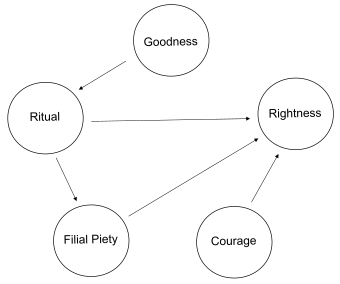
Figure 2. Suggested relationships between goodness, ritual, filial piety, courage, and rightness.
Inherent Conservatism
The Analects have been used in a variety of ways, and have had significant influence on the structure of the civil service in a variety of kingdoms in China across millennia. There is the fairly common belief that Confucianism is to a large degree conservative, and tends to support the status quo, and in that case functions as an ideology of the ruling classes.
At the same time, the Analects can be read as instruction in the knowledge and acquisition of power, and can therefore aid those who wish for and would implement change.
> When the state possesses the Way, be audaciously correct in both word and action; when the state lacks the Way, be audaciously correct in action, but let one's speech be conciliatory. (14.3).
Bibliography
The pagination referenced and commentary resources were drawn from Confucius. (2003). Analects: With Selections from Traditional Commentaries. Slingerland, E., Trans. Indianapolis: Hackett Publishing.
Thai Alphabet Tone Graphs 12 Nov 2018 8:10 PM (6 years ago)
Updated 03-Aug-2025
The second edition of the Thai Alphabet Cards is underway, and we've revamped the Tone Graphs, among other elements.
Changes in Central Thai Tones over Time
There is significant evidence for changes in the standard tones in Central Thai over time. While this is an important aspect of tone, and intermediate learners should become sensitive to this (as well as other important aspects of tone, which is quite complicated in running speech), still we have made the decision to use a common and conservative model for displaying tones on the Thai Alphabet cards.
For a model, we've revisited the original tone graphs of Arthur S. Abramson from his work The Vowels and Tones of Standard Thai: Acoustical Measurements and Experiments, International Journal of American Linguistics, Vol. 28, No. 2, April, 1962. This work is, after 44 years, still seen as the standard.
We've spent considerable time reviewing the literature since (and before) 1962, and especially the evidence presented for historical changes to the tones which have occurred since Abramson's published early work. While there are many publications, most have severe problems with them which prevent using any as a reference for the tone changes. In many cases, single case examples or synthetic averages are presented, but without the primary goal of a new standard, and therefore without the methodological rigor needed for adopting changes in the contours.
Again, there is evidence for changes to the tones of Central Thai over time, specifically by reviewing differences between a younger cohort and an older cohort, as presented in Inter- and intraspeaker variability inf undamental frequency of Thai tones, by Gandour, Potisuk, Ponglorpisit, and Dechongkit, Speech Communication 10 (1991), pp.355-372.
There is an intriguing article proposing a mechanism for tone change using Gedney's tonebox by Pittayawat Pittayaporn entitled Directionality of Tone Change, 2007. However, the so-called Thai tonal space in 4 stages suffers dramatically from a very poor choice of tonal examples in stages 3 and 4 (a single sample, and a synthetic result from a study contrasting tones in isolated exemplars vs. connected speech, respectively). While the data is insufficient in evidence, the underlying mechanisms still appear plausible, though would not operate in isolation from the population of speakers and vast variety and import of second languages on Central Thai (Siamese).
Abramson (1962) as the Signal Reference Work
Besides the fact that there is no real reference work that we might use with full plausibility, there are other reasons why the traditional tone graphs are best suited for the Thai Alphabet Cards:
- These tone graphs are seen as standard and conventional, unremarkable in a positive way.
- For beginning Thai speakers, these tone contours will most likely match what native Thai teachers have been taught, and emulate in the classroom.
- As these traditional graphs represent an older, as opposed to a younger set of speakers, it will be more common in traditional media and among (older) spoken adults.
- The traditional tone graphs are still accurate (enough) and appropriate even with the supplemental research which has occured since then (see Abramson Thai Tonal Space 1997, where he writes The "ideal" contours found in earlier work ... are still quite acceptable for isolated Thai words).
- Nearly all research has focused on the long vowel tones only, and do not include short vowel tones, as does the original Abramson (1962) work.
- The only change of tone of significance is the shape of the high tone, which appears concave rather than convex (sometimes labeled a high-rising tone in contrast to the standard rising tone being labeled a low-rising tone.
- Whether the high / high-rising tone ends with a downturn is generally better supported (and is at worst seen as one of two standard contours), and aligns with the Abramson (1962) contour.
Use of the Abramson (1962) Tone Contour Figures
To align the Tone Graphs in the Thai Alphabet Cards, we acquired an original copy of Abramson (1962) and scanned the two tone graphs (figures 3.5, 3.6 on pp. 126-127). We then scanned the figures into PDF format and and imported them into the Inkscape vector graphics program. We then traced the contours and separated them into individual graphs.
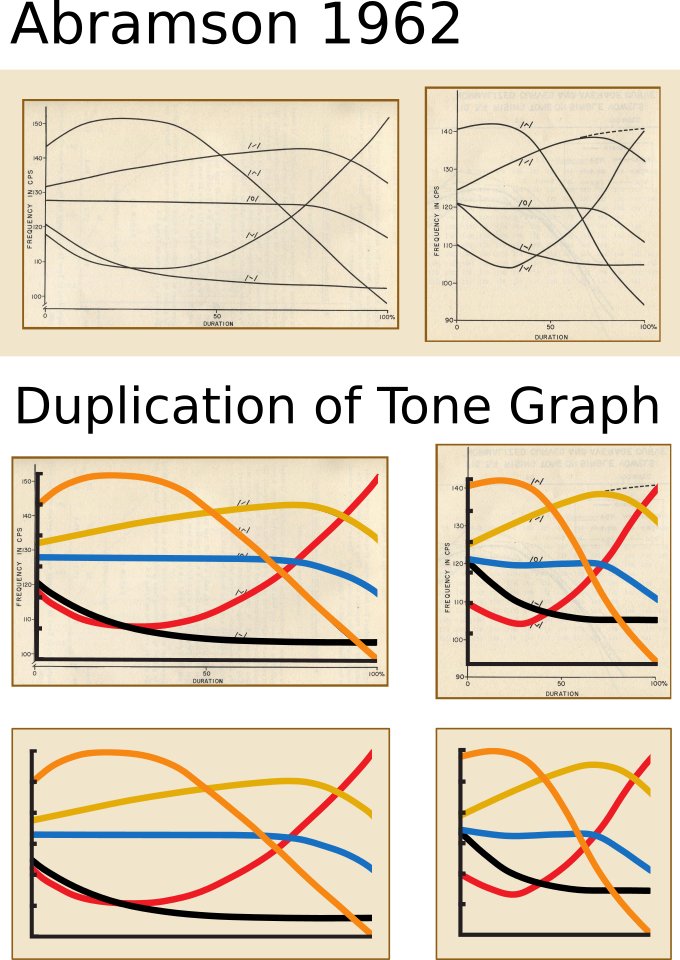
Changes to the Thai Alphabet Cards Tone Graphs
The main changes are a return to the original tone countours, as well as aspect ratio and shape. This also reduces the space used by the graphs without reducing information.
Below is the example for ฒอ ผู้เฒ่า (thɔɔ phûuthâw / tʰɔː pʰûː tʰâw / tɔɔ pŭu-tâo), which has one long mid tone, one long falling tone, and one short falling tone.
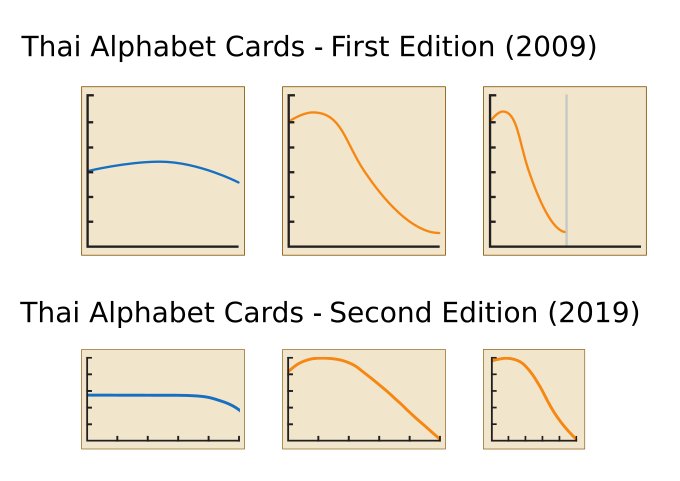
Comparison of Short and Long Vowel Tones
Note that there is a bit less distortion in the short vowel tone (which was only a compressed long vowel tone, which was based on Naksakul (1977) Thai Phonology as adapted in the Elementary Thai for Foreigners text as published and taught by the Linguistics program at Mahidol University (1991).
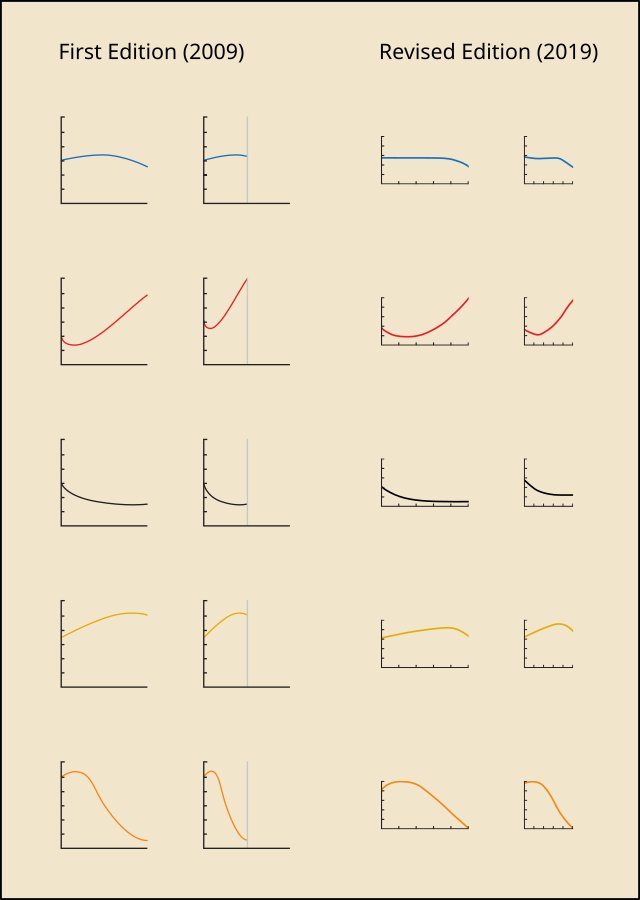
Fonts with Thai & Roman (Latin) 22 Sep 2018 5:04 AM (7 years ago)
Updated 03-Aug-2025
One challenge for using Thai script on a computer is that Thai characters are more vertical than roman alphabet characters. If one is mixing roman and Thai characters in a document, the Thai characters tend to be much smaller (and therefore illegible if the roman characters are optimized for space and legibility). The reason for this is that Thai characters, along with vowel markers, tone marks, and the silent marker can stack above and below a character, which means they are generally much taller than Roman (Latin) and other alphabet systems.
- Update - see this collection of open source and free Thai fonts, including most of the fonts listed below.
A good (bad) example is the very legible source code editing font Hack which does not have Thai character support. This means the operating system substitutes the Thai system font, which makes reading difficult. The best that can be done is increasing the font size and decreasing the line height and the line length. This can make the latin characters less legible.
Fonts with Good Thai and Roman Character Support
When this post was first created in Nov. 2013 there were three fonts that I focused on. Those fonts listed were:
- Linux Libertine
- TH Charmonman
- TH Fah kwang
Since then we've gone on to create a large collection of open source and free Thai fonts, so there are more to choose from, as well as a few more added from additional sources (all open source or at least free to use).
Good support for English and Thai
- Arundina Sans an original SIPA project which has been extended by TLWG
- Garuda part of the NECTEC/TLWG release
- Linux Libertine from the Libertine Open Fonts Project
- Noto Sans Thai a Google Font
- Mitr by Cadson Demak (Available on Google Fonts)
- Prompt by Cadson Demak (Available on Google Fonts)
- Waree, aka Thai Waree, another TLWG font
- Itim a Cadson Demak font
- Sawasdee a Cadson Demak font
- Sriracha a Cadson Demak font
- TH Charmonman a DIP/SIPA Govt font
- TH Fah kwang a DIP/SIPA Govt font
Note that all the fonts listed above with the exceptions of Linux Libertine, Arundina Sans, and Waree are available in the Free Thai font collection. We will be adding Arundina and Waree to the Thai Font Collection in the next month or two.
A Note on Linux Libertine
Linux Libertine continues to amaze as a one of the most successful open source truetype font projects has excellent Thai character support. Actually, Linux Libertine has zero Thai character support, but the default Thai font substitution works well with Linux Libertine.
Understanding Thai Transcription 21 Sep 2018 10:20 PM (7 years ago)
Updated 03-Aug-2025
INCOMPLETE - WORK IN PROGRESS It is common for those learning Thai to run across transcription of spoken Thai into systems other than the Thai script. At first, one would think that there would be a single correct transcription, for example based on the International Phonetical Association (IPA) that would accurately capture all the sounds in Thai. One would be wrong. There are a large number of transcription/transliteration systems, each with their own history and rationale. Understanding more about them is useful to Intermediate Thai language learners. Normally a beginning learner is simply at the mercy of whatever Thai language books/material and/or Thai teacher/tutor is most convenient or chosen for the learner. As for the author of this essay, I held a bias against the IPA system as I wondered why I had to learn a third system in order to learn the second system (Thai). It turns out I was incorrect and it would have been better to learn not only the phonemes and phonology of Thai, but also that of English. A better understanding of both is the key to cutting through the confusion of Thai transcription systems that proliferate. Topics to follow: - Transcription system goals - Script-to-script - Sound-to-script - Reversibility - Sound-to-sound - ASCII/En keyboard transcription - Transcription systems - True (full) IPA - Hybrid systems - AUA -
Speech Perception Research 23 Mar 2018 11:07 PM (7 years ago)
Updated 03-Aug-2025
While Speech Perception Research is a large and dynamic area of study, some recent findings can be summarized in a way that helps us better approach second language learning and teaching.

Accent-Independent Ataptation to Foreign Accented Speech
Accent-independent adaptation to foreign accented speech indicates that training on a set of foreign accents produces significant gains in comprehension with those accents as well as other non-training-set foreign accents. The idea is that foreign accents are systematic (in relation to the native foreign language), and learning a set of accents is generalizable across other accents.
Possible Ramifications
For second language learners who second langauge has a set of accents in general, training on these accents, in addition to a primary general standard speakers, could be of assistance. For example, in Thailand a majority of the population does not have Standard Thai as a mother tongue and to some degree have accents that are shaped by their native language (with the largest number of speakers represented by: Isan, Northern Thai, and Southern Thai).
Practice with representative speakers of these mother tongues will increase overall understanding of the variety of accents of speakers of Standard Thai.
Perceptual Learning of Time-Compressed Speech
Perceptual Learning of Time-Compressed Speech indicates that specific training on Time-Compressed Speech, and subsequent follow-up training and exposure induces better understanding to a greater degree than expected.
Possible Ramifications
Time-Compressed, or fast speaking language should be introduced and integrated into second language learning, as a special aspect, with follow up training.
Reverse Hierarchies and Sensory Learning
Reverse Hierarchies and Sensory Learning discusses a useful theory to how second language learners make phonetic discrimination that relies on already built-up higher-level constructs rather than lower-level data that is available.
> Our typical perceptual experiences (i.e. our conscious perception) reflect only the information stored at higher levels.
Possible Ramifications
RHT is a powerful approach to understanding learning and perception in general. It can provide a clear explanation for second language learners why they don't hear a sound properly. It also provides a clear way to devise training on things such as novel sounds and lexical characteristics in a second language.
Auditory-Perceptual Learning Improves Speech Motor Adaptation in Children
Auditory-Perceptual Learning Improves Speech Motor Adaptation in Children underscores the importance of hearing to speech production. Focused training on speech perception provides a stronge catalyst for speec production.
Possible Ramifications
Auditory feedback as a mechanism for auditory training and perceptual learning has an impact in performance of speech production. Training the ear is essential.
An interactive model of auditory-motor speech perception
An interactive model of auditory-motor speech perception, as above, provides strong evidence for an interactive model of auditory, somatosensory, and motor regions in effective speech. While highly interactive, the ear is still considered primary and the voice a secondary, modulatory role.
Possible Ramifications
Speech production and listening training should be taught as a joint exercise rather than as separate and distinct.
Plasticity in the human speech motor system drives changes in speech perception
Plasticity in the human speech motor system drives changes in speech perception points to a dramatic plasticity in the human speech motor system, but even moreso that the motor system is a driver in perception.
Possible Ramifications
A strong argument for conjoining listening and speech production together, as is noted in other studies above.
Thai Languages 18 Mar 2018 11:11 PM (7 years ago)
Updated 03-Aug-2025
Thai languages, or languages in Thailand, are many and diverse. Scholars generally use the term Tai to refer to a larger language family which ranges across much of Mainland Southeast Asia and what is now Southern China. The main point is that there is ongoing research, different ideas, and not full agreement, on how to distinguish which languages are related to each other and which are siblings and which are parent languages.

Languages vs. Dialects
There is not a clear distinction where a dialect ends and a language begins. Presumably dialects are regional pronunciations and special local terms, whereas languages have much more of a difference which can result in mutual unintelligibility (the speaker of one language cannot understand the speaker of another language). Speakers of a language can grow apart, and their language then grows apart, resulting in two or more languages.
Languages can also come together over time, such that a separate language starts to become mutually intelligible, where before it was not. And finally, many societies have multiple languages in use, and so intelligibility comes from close physical proximity of the languages and the speakers in the local area.
What usually happens in this case is that one language which is not a local language, and not the mother tongue of a majority of the inhabitants, is priviledged as a language of education or the economy.
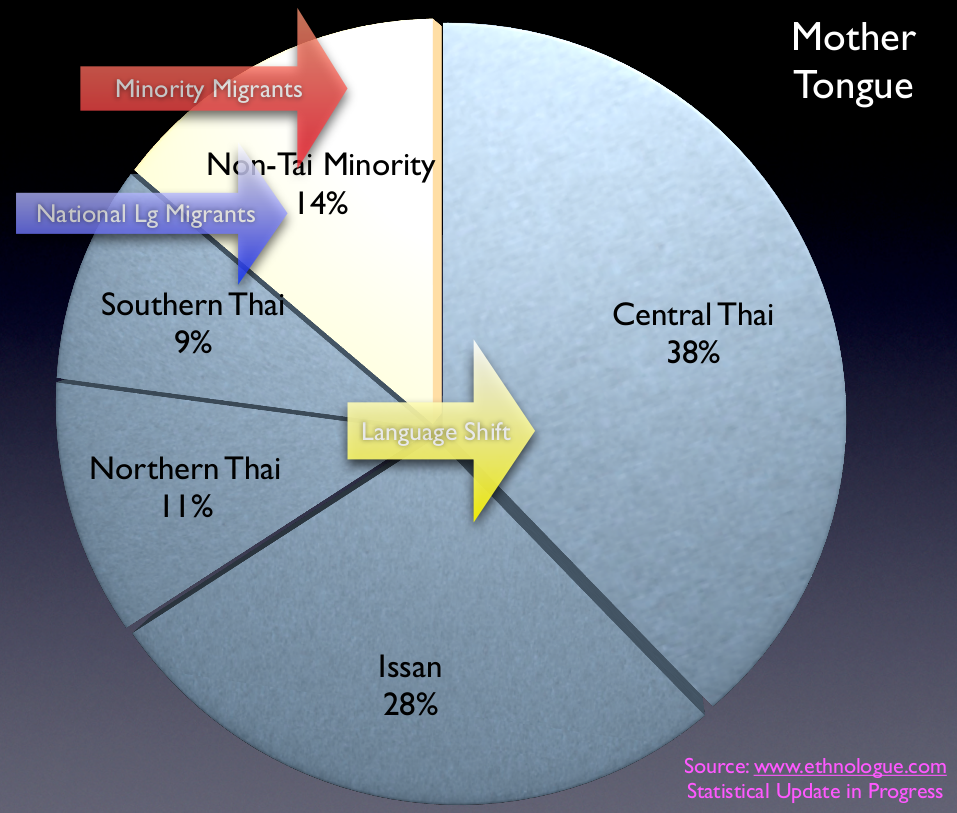
Thai Language, Tai Languges, &c.
In Thailand as functional mother tongues there are dozens and possibly hundreds of linguistic communities. Setting aside the many minority languages for example of immigrants and hill tribes, there are five predominant languages which number in the million or more speakers, those are:
- Kham Muang / Lanna / Northern Thai - spoken in parts of Northern Thailand, Western Laos and Northeastern Myanmar
- Isan / Lao / Northeastern Thai - there are six (or more) dialects of Lao and each of them is spoken in Isan, hence the Isan language is simply the Lao language, spoken in Northeastern Thailand
- Standard Thai / Central Thai / Siamese / Thai
- Southern / Dambro / Southern Thai - Phasa Dai ภาษาใต้
- Yawi / Pattani Malay - Phasa Yawi ภาษายาวี
- Northern Khmer / Surin Khmer - Phasa Khmer ภาษาเขมร
This rough diagram of the various spheres of influence of various kingdoms from ~1400 CE indicates how the linguistic cultures were set by then. Nonetheless, minority languages abound and a given kingdom's border is more or less then operating area for a primary language, rather than the erasure of minority languages. The borders of those kingdoms are still very much present in the mother tongue of the populations in different parts of Thailand. But again, the nation state of Thailand itself with Central Thai is still a minority language in terms of first language use.

How to Understand the Relations between Thai Languages
There are different ways of relating these languages to each other, but present scholarship is best understood as making the modern languages siblings at most, and unrelated languages most likely. It is common to hear each of these languages (with the exception of Malay) as being Thai, Thai Languages or Dialects of the Thai Language. Certainly they are languages spoken in Thailand, and have been for generations.
However, it is not accurate or useful to refer to these languages a part of a single language. Beyond the fact that these are generally mutually unintelligible, they also have very different histories and play a different function in the societies in which they live. Each is a mother tongue for a significant population, whereas Central Thai / Siamese is the national/government language. All languages except for Central Thai have been largely supressed as part of a nationalist Thaification policy which began in the 1940s and is operating up through the present.

Thai vs. English Consonants 18 Jul 2017 2:54 AM (8 years ago)
Updated 03-Aug-2025
Comparing and contrasting the similarities and differences between two languages is an effective tactic for second language learners. Direct cognitive awareness of those differences, while engaging in recognition and production of the differences, is more effective than indirect trial and error. Instruction and exercises that highlight these differences are important for mastery.
> This is an actively edited page, and will expand into a full book chapter. Comments are welcome.
There are several consonants that are not identical to English consonants in sound and production of that sound. For learners of Thai, the main approach is to keep things as simple and uncomplicated as possible, in order to make forward progress, rather than get bogged down in the details. Therefore, what follows should not been seen as a starting point, but something to return to once some progress is made (for example, working with a teacher or tutor and getting through the alphabet in terms of reading, writing, speaking, and recognizing).
What follows may be important for some learners to know about what is being simplified. However, please avoid the all-too-common bad habit of trying to correct one's Thai teacher who is really trying to develop a skill in their students, with what follows, which is a technical and linguistic discussion.
English Consonant Sounds not in Thai
There are several English consonant sounds not found in Thai, including:
- Th - this
- Th - thigh
- V - vowel
- Z - zoo
- R - right (Thai R is a different sound, a trilled R)
- G - guy (Thai G is transcribed as K, a more uvular sound), there may be disputable
- Ch and J are transcribed differently, but act as a related pair, and can be considered allophones
- Sh (ʃ) - ship
- Zh (ʒ) - vision
In-between Consonant Sounds
- In Thai there are consonants with a b sound, a p sound, and an in-between b+p sound (a sound not in English). For English speakers, they will not necessarily recognize the bp sound as being distinct but hear it as a b or a p.
- In Thai, there are consonants with a d sound, a t sound, and an in-between d+t sound (a sound not in English). For English speakers, they will not necessarily recognize the dt sound as being distinct but hear it as a d or a t.
Ng Sound Consonant
In Thai there is a consonant that is equivalent to an ng sound, as found in words like song and sing (and every -ing verb ending). While this sound is in English, it is usually only in "final consonant position", that is, with a consonant and a vowel before it. In Thai, this consonant can be in "initial consonant position" which can be initially difficult to hear and produce for English speakers.
Thai Consonant Sounds (Phonemes) not in English
There are four categories of Thai Consonant Sounds not in English:
- Those sounds which have related sounds (allophones) which are intelligible (k-kh vs. g-k), (tɕ-tɕʰ vs. dʒ-tʃ). Since these are arguable allophones of a phoneme and each case roughly matches what we hear and produce in either language, it is simply the case that we should follow what is standard practice in the majority of Thai language courses. That is, yes there is a difference in manner and place of articulation (in some majority of cases), but the congruent consonant sound in the other language is functionally allophonic. K (gau gai) in Thai is G in English and Kh in Thai (kau khai, etc.) is K in English. This also makes sense of the K as final consonant sound, where we may "hear" an English K, this is due in part to the "final oral plosives are said to be accompanied by simultaeous glottal closure" (Tingsabadh & Abramson, 1993). That is, we don't hear the full sound, aspiration or otherwise, and so the sound is interpreted as a g or a k, by an English speaker.
- Those sounds which can be confused with other sounds (that is, Thai has finer gradations and discriminations) (d-dt-t; b-pb-p)
- Those sounds which have nothing related in English (with some exceptions), namely the glottal stop (represented by a character that looks like a question mark ʔ/?)
- In the fourth category, the sound is in English, but it is used in a different way that can be confusing (ng)
The R Consonant in Thai
In Thai there is an r consonant (actually three, including two rare compound consonants), but they differ from an English R in several ways. First, it is predominantly spoken as an L rather than an R in most everyday conversation. Secondly, when it is pronounced, it is a trill or rolling form of r, similar to a French r, rather than an English r. Finally, in many fonts, the r character script looks like an English s, as well as the standard Thai ร.
Missing Consonant Clusters
Consonant clusters are not included in phonetic charts for languages, namely because the information for sounds are already represented. Unlike dipthongs which have a direction and therefore can be plotted, consonant clusters are seen as merely additive. However, for the language learner, recognizing (hearing) and producing (saying) those clusters requires practice as with the individual consonants themselves.
Final Consonant Sounds in Thai
Not only are there changes in what a given letter becomes (transformation) in the final consonant position (fewer sounds are possible in the final consonant position), but also the consonant sound is cut short or muffled in many ways. This has an impact not only on Thai learners unable to pronounce final consonants fully in English (especially the final S in plurals), but also certain final consonant sounds will be heard as a different sound, to match Thai phoneme patterns, e.g., path -> pap, ball -> ban.
Note on Minimal Pairs Training
Explicit training with minimal pairs is the most common drill-style method of learning the difference between two sounds and between two tones. Specifically, phonemic boundaries are being introduced (and re-established) for the second language learning, in order for them to hear more accurately the sounds in the target language. Minimal pairs can be very useful when used in a focused way, in terms of establishing production and recognition skills. However, in many cases adult learners starting out won't hear the differences, but that should not start some learning from getting underway.
Resources
- Thai and English Consonantal Sounds: a Problem or a Potential for EFL Learning? Monthon Kanokpermpoon, ABAC Journal, V.27,N.1.
> This paper aims to examine similarities and differences between Thai and English consonants. It determines areas of difficulties when Thai students try to pronounce English consonantal sounds. It is found that English sounds which do not occur in the Thai phonology tend to pose great difficulty for Thai students to utter. Those sounds include /g/, /v/, /T/, /D/, /z/, /S/, /Z/, /tS/, and /dZ/. Sounds which exist in Thai but can occur in different environment, i.e. syllable position, are also prone to be difficult to pronounce. Such examples are /f/ and /s/. To tackle the problem of sounds nonexistent in Thai, Thai students are likely to substitute Thai sounds for the English sounds. In addition, the phenomenon where /l/ and /R/ are used interchangeably in Thai tends to be transferred in pronouncing /l/ and /r/ in English with great challenges.
